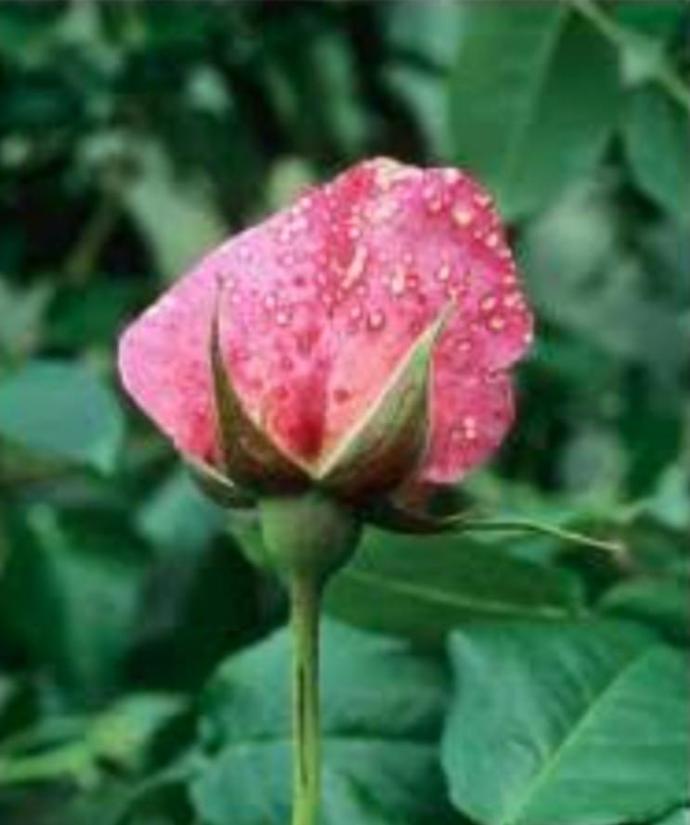Ordinary rose Plant
ORDINARY ROSE, referring to standard rose varieties, requires well-draining soil with full sun exposure. Water consistently, and prune to shape the rose bush. Fertilize during the growing season for optimal flower production. Deadhead spent flowers for continuous blooming. 
Habit
Shrub
Height
1-2 m
Growth
Fast
Soil
Well Drained , Loamy
Shade
Full Sun
Moisture
Low
Edible
Yes
Medicinal
Yes
Origin
Worldwide
Climatic Condition
Temperate, Subtropical
Temperature (°)
15-25°C
Humidity (%)
60-80%
Potting media
Loamy, peat
Fertilizers
Balanced NPK (10-10-10)
Watering
Regular, deep watering
Plant Weight
300-500 g
Flowering Time
Spring, Summer
Soil Ph level
6.0 - 7.0
Water Ph level
6.5 - 7.0
Soil EC
1-2 dS/m
Yield Per Plant
25 - 500 flowers
NPK ratio
10:10:10
life Span
Perennial
Health Benefits
Anti-inflammatory, aids in relaxation
Suggested Grow Media or Potting Mix ?
50% loamy soil, 30% compost, 20% sand
Suggested Fertigation/Fertilizers
Fertilize every 6 weeks with a balanced, slow-release fertilizer.
Common Diseases and Remedies
Rust, Ghost spotting.
Yellow spots on upper surface, Removing of infected blooms.
Neem Oil , Lime sulphur.
HEALTH BENEFITS
- Rich in vitamin C, supporting immune and skin health.
- Rose petals and extracts have antioxidant and anti-inflammatory properties.
- Rose water helps with digestion, stress relief, and skin hydration.
- Rose essential oil has calming effects, reducing anxiety.
What Is An Common Rose?
Common Rose usually refers to traditionally grown varieties of rose flowers, often with a classic appearance and fragrance. These roses come in a variety of colors, including red, pink, white, and yellow, and are often grown as ornamentals in gardens and landscapes. Common roses usually refer to common rose varieties that are widely available in gardens, florists, and flower arrangements. These roses come in a variety of colors, including red, pink, white, and yellow, and have a classic rose appearance with petals arranged in layers around a central core.

What Are The Different Types Of Common Rose?
1. Hybrid Tea Rose
Known for its large single flowers on long stems, it is often considered the classic cut rose.
2. Floribunda Rose
Characterized by clusters of small flowers on short stems, this flower brings rich color to the garden.
3. Grandiflora Rose
A cross between a hybrid tea rose and a floribunda rose, large flowers bloom in clusters on tall stems.
4. Climbing Roses
These roses have long canes and can be trained to climb walls, trellises, or arbor, adding a vertical element to your garden.
5. Miniature rose
A compact version of the larger rose, often grown in pots or used for borders and edging.

How To Care For Common Rose?
1. Location
Common roses, like most other types of roses, require well-drained soil, plenty of sunlight (at least 6 hours a day), and Grows with proper air circulation. It can be planted in gardens, raised beds, containers, or along borders. Choosing a location with good air circulation is important to prevent disease and ensure fertile, well-drained soil. Also, avoid areas with heavy foot traffic or standing water.
2. Sunshine
"Sunshine on an Ordinary Rose" can be interpreted figuratively, suggesting that given the right conditions, such as sunlight, even ordinary things can grow and bloom. I am. This reflects the idea that everyone has the potential for growth and beauty, regardless of their perceived status or personality.
3. Soil
For common roses, a suitable soil mix is usually a combination of garden soil, compost and well-rotted manure. This mixture provides the nutrients and drainage your roses need for healthy growth. Additionally, adding perlite or sand will improve drainage and air permeability. Roses prefer slightly acidic conditions, so make sure the soil pH is slightly acidic to neutral, ideally around 6.0 to 7.0. Amending the soil with organic matter and fertilizing regularly during the growing season will help your roses thrive.
4. Hydration
To hydrate common roses, you usually need to give them enough water to evenly moisten the soil without making it wet. Water generously at the base of the plant, rather than lightly watering the surface. Try to water roses early in the morning to prevent evaporation and reduce the risk of fungal diseases. Additionally, mulching around the base of your plants will help retain moisture in the soil.

5. Nourishment
To nourish your common rose, make sure it gets plenty of sunlight (at least 6 hours each day) and water it regularly (about once a week). inches), providing well-drained soil rich in organic matter. Case. Consider fertilizing with a balanced rose fertilizer during the growing season. Additionally, prune dead or diseased branches and remove spent flowers to encourage new growth and flowering.
6. Issues
Roses are susceptible to many diseases and pests, the most common of which are black spot, Cercospora spot, aphids, and sawflies. Monitor your rose plants throughout the growing season by inspecting the leaves, buds, and stems for symptoms such as spots, dark spots, sticky residue, holes in the leaves, and yellowing or warping of the leaves.
What Are The Benefits Of Common Rose
Aesthetic Appeal Roses are prized for their beauty and are often used in flower arrangements, landscaping, and as cut flowers to decorate rooms. Symbolism Roses have deep cultural and symbolic meaning and represent love, romance, and admiration. It is often given as a gift for special occasions. Fragrance Many types of roses have pleasant scents that uplift the mood and enhance the atmosphere of gardens and indoor spaces. Therapeutic Benefits Rose essential oil is used in aromatherapy for its calming and uplifting effects. Rose water is also known for its calming properties and is used in skin care. Culinary Uses Roses are edible and can be used to flavor dishes, prepare tea, and garnish desserts. It gives dishes a delicate floral flavor. Medicinal Uses Traditional medical systems use roses for a variety of medicinal purposes, including the treatment of skin diseases, digestive problems, and menstrual problems. Environmental benefits Roses attract pollinators such as bees and butterflies, which contribute to ecosystem health and biodiversity.

FAQs About Growing Common Rose
1. How to maintain ordinary rose?
Watering Roses require regular watering, especially during dry spells. Water deeply, allowing the soil to dry slightly between watering to prevent root rot. Fertilizing Apply a balanced fertilizer formulated for roses during the growing season (spring through fall) according to package instructions to promote healthy growth and abundant blooms. Pruning Prune your roses in late winter or early spring to remove dead or diseased wood and shape the plant. Also, remove spent flowers throughout the growing season to encourage continuous blooming. Mulching Apply a layer of organic mulch, such as wood chips or compost, around the base of the rose plant to help retain moisture, suppress weeds, and regulate soil temperature. Sunlight Roses thrive in full sun, so ensure they receive at least 6-8 hours of direct sunlight daily for optimal growth and flowering. Disease and pest control Keep an eye out for common rose diseases like powdery mildew and black spot, as well as pests such as aphids and thrips. Treat as needed with appropriate fungicides or insecticides.
2. What are the uses of ordinary rose?
Ornamental Purposes Garden roses are primarily grown for their beauty and fragrance, making them popular choices for landscaping, gardens, and floral arrangements. Cut Flowers Garden roses are frequently used in bouquets, floral arrangements, and as cut flowers for special occasions such as weddings, anniversaries, and Valentine's Day. Perfume Production Some varieties of roses are used in the production of perfumes and essential oils due to their pleasant fragrance. Culinary Uses Certain varieties of roses are edible and can be used to flavor foods, make rose water, or garnish dishes in culinary applications. Medicinal Purposes Roses have been used in traditional medicine for centuries for their potential health benefits, such as improving skin health, reducing inflammation, and relieving stress. Symbolism Roses hold symbolic meaning in many cultures and are often given as gifts to express love, affection, or sympathy. Overall, ordinary roses have a wide range of uses beyond their aesthetic appeal, making them versatile and valuable plants in various industries and contexts.
3. Can I grow ordinary rose indoor?
Yes, you can grow ordinary roses indoors, but it can be challenging because they typically require a lot of sunlight and space. You'll need a sunny window or artificial grow lights, well-draining soil, and regular watering. Compact or miniature rose varieties might be more suitable for indoor cultivation due to their smaller size.
4. Which pot is best for growing ordinary rose?
For growing ordinary roses, it's best to choose a pot that is at least 15-20 inches in diameter and has good drainage holes at the bottom. Terra cotta or plastic pots are commonly used for roses, as they provide good drainage and are durable. Ensure the pot is large enough to accommodate the root system and has enough depth for proper growth.
5. From where can I shop for ordinary rose?
You can find ordinary roses at various places such as flower shops, grocery stores, farmers' markets, or online flower delivery services.

